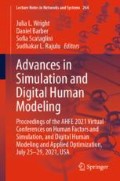Abstract
This paper describes the importance of visualization to support after-action review technologies to develop appropriate human-autonomy team dynamics. Key to developing accurate visualizations in this context requires the capability to quantify critical team dynamics by parsing large, diverse sensor data in offline, low-latency environments. Here, we describe the use of open-source technology and scalable web-based applications for the quick ingestion of these massive datasets and timely visualizations for the AAR process for the development of the Global After-Action Review Technology. This technology explores human-autonomy team interaction problems by identifying key features needed for computer vision, including image classification, object recognition, scene understanding, gait recognition, pose estimation, tracking, and behavior recognition.
Access this chapter
Tax calculation will be finalised at checkout
Purchases are for personal use only
References
Smith-Jentsch, K.A., Johnston, J.H., Payne, S.C.: Measuring team-related expertise in complex environments (1998)
McNeese, N.J., Demir, M., Cooke, N.J., Myers, C.: Teaming with a synthetic teammate: insights into human-autonomy teaming. Hum. Factors 60, 262–273 (2018)
De Dreu, C.K., Weingart, L.R.: Task versus relationship conflict, team performance, and team member satisfaction: a meta-analysis. J. Appl. Psychol. 88, 741 (2003)
Marks, M.A., Mathieu, J.E., Zaccaro, S.J.: A temporally based framework and taxonomy of team processes. Acad. Manag. Rev. 26, 356–376 (2001)
Blickensderfer, E., Cannon-Bowers, J.A., Salas, E.: Theoretical bases for team self-correction: fostering shared mental models. Adv. Interdisc. Stud. Work Teams 4, 249–279 (1997)
Endsley, M.R.: Toward a theory of situation awareness in dynamic systems. Hum. Factors 37, 32–64 (1995)
Salas, E., Sims, D.E., Burke, C.S.: Is there a “big five” in teamwork? Small Group Res. 36, 555–599 (2005)
Marks, M.A., Panzer, F.J.: The influence of team monitoring on team processes and performance. Hum. Perform. 17, 25–41 (2004)
Schaefer, K.E., Aksaray, D., Wright, J., Roy, N.: Challenges with addressing the issue of context within AI and human-robot teaming. In: Computational Context, pp. 80–96. CRC Press (2018)
Schaefer, K.E., Oh, J., Aksaray, D., Barber, D.: Integrating context into artificial intelligence: research from the robotics collaborative technology alliance. AI Mag. 40, 28–40 (2019)
Brewer, R.W., Cerame, E., Pursel, E.R., Zimmermann, A., Schaefer, K.E.: Manned-unmanned teaming: US army robotic wingman vehicles. In: Cassenti, D.N. (ed.) AHFE 2018. AISC, vol. 780, pp. 89–100. Springer, Cham (2019). https://doi.org/10.1007/978-3-319-94223-0_9
Schaefer, K.E., Baker, A.L., Brewer, R.W., Patton, D., Canady, J., Metcalfe, J.S.: Assessing multi-agent human-autonomy teams: US Army Robotic Wingman gunnery operations. In: Micro-and Nanotechnology Sensors, Systems, and Applications XI, p. 109822B. International Society for Optics and Photonics (2019)
Brewer, R.W., Walker, A.J., Pursel, E.R., Cerame, E.J., Baker, A.L., Schaefer, K.E.: Assessment of manned-unmanned team performance: comprehensive after-action review technology development. In: Chen, J. (ed.) AHFE 2019. AISC, vol. 962, pp. 119–130. Springer, Cham (2020). https://doi.org/10.1007/978-3-030-20467-9_11
Uttal, D.H., O’Doherty, K.: Comprehending and learning from ‘visualizations’: a developmental perspective. In: Gilbert, J.K., Reiner, M., Nakhleh, M. (eds.) Visualization: Theory and Practice in Science Education, pp. 53–72. Springer, Dordrecht (2008). https://doi.org/10.1007/978-1-4020-5267-5_3
Rapp, D.N., Kurby, C.A.: The ‘ins’ and ‘outs’ of learning: Internal representations and external visualizations. In: Gilbert, J.K., Reiner, M., Nakhleh, M. (eds.) Visualization: Theory and Practice in Science Education, pp. 29–52. Springer, Dordrecht (2008). https://doi.org/10.1007/978-1-4020-5267-5_2
Aigner, W., Miksch, S., Müller, W., Schumann, H., Tominski, C.: Visualizing time-oriented data—a systematic view. Comput. Graph. 31, 401–409 (2007)
Tufte, E.R.: The Visual Display of Quantitative Information. Graphics Press, Cheshire (2001)
Von Krogh, G., Von Hippel, E.: The promise of research on open source software. Manag. Sci. 52, 975–983 (2006)
Command, U.: Training and qualification, crew. US), DotA (ed.) Training Circular No.: TC 3-20.31 (2015)
Baker, A.L., Schaefer, K.E., Hill, S.G.: Teamwork and Communication Methods and Metrics for Human-Autonomy Teaming. CCDC Army Research Laboratory Aberdeen Proving Ground United States (2019)
Acknowledgments
The views and conclusions contained in this document are those of the authors and should not be interpreted as representing the official policies, either expressed or implied, of the Army Research Laboratory or the U.S. Government. The U.S. Government is authorized to reproduce and distribute reprints for Government purposes notwithstanding any copyright notation herein.
Author information
Authors and Affiliations
Corresponding author
Editor information
Editors and Affiliations
Rights and permissions
Copyright information
© 2021 The Author(s), under exclusive license to Springer Nature Switzerland AG
About this paper
Cite this paper
Taberski, M., Davis, K., Schaefer, K.E., Brewer, R. (2021). Visualizing Human-Autonomy Team Dynamics Through the Development of a Global After-Action Review Technology. In: Wright, J.L., Barber, D., Scataglini, S., Rajulu, S.L. (eds) Advances in Simulation and Digital Human Modeling. AHFE 2021. Lecture Notes in Networks and Systems, vol 264. Springer, Cham. https://doi.org/10.1007/978-3-030-79763-8_6
Download citation
DOI: https://doi.org/10.1007/978-3-030-79763-8_6
Published:
Publisher Name: Springer, Cham
Print ISBN: 978-3-030-79762-1
Online ISBN: 978-3-030-79763-8
eBook Packages: Intelligent Technologies and RoboticsIntelligent Technologies and Robotics (R0)

